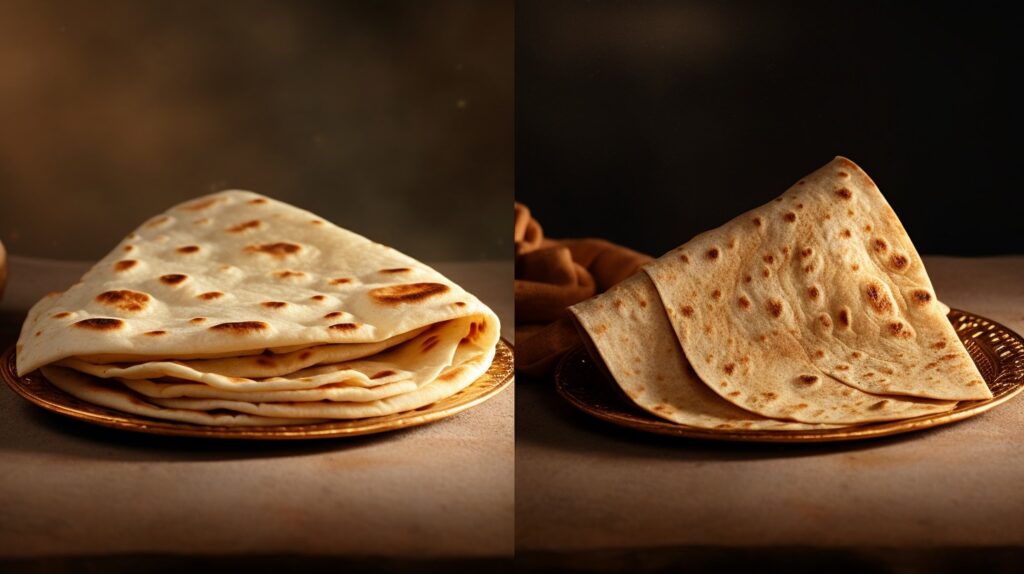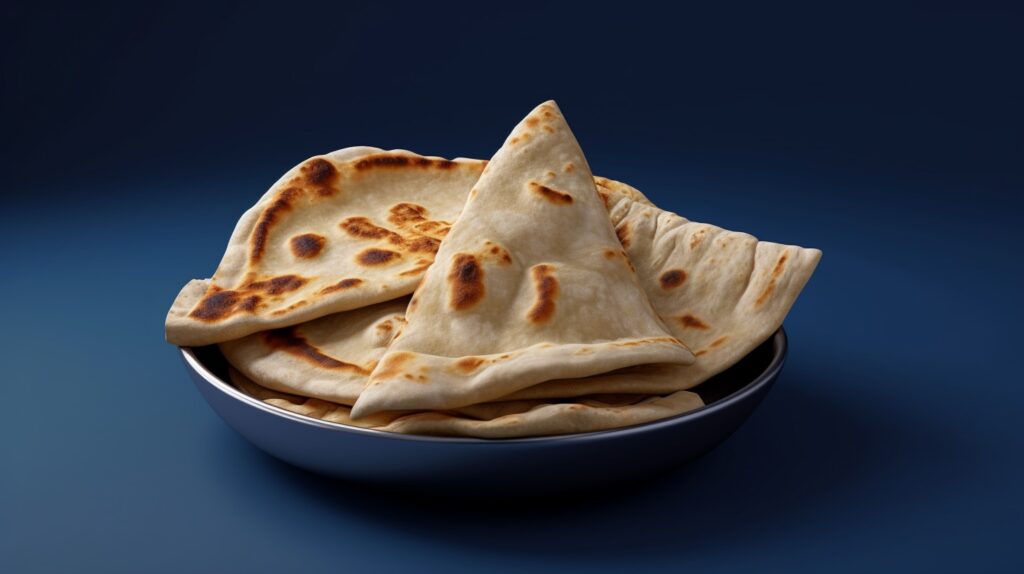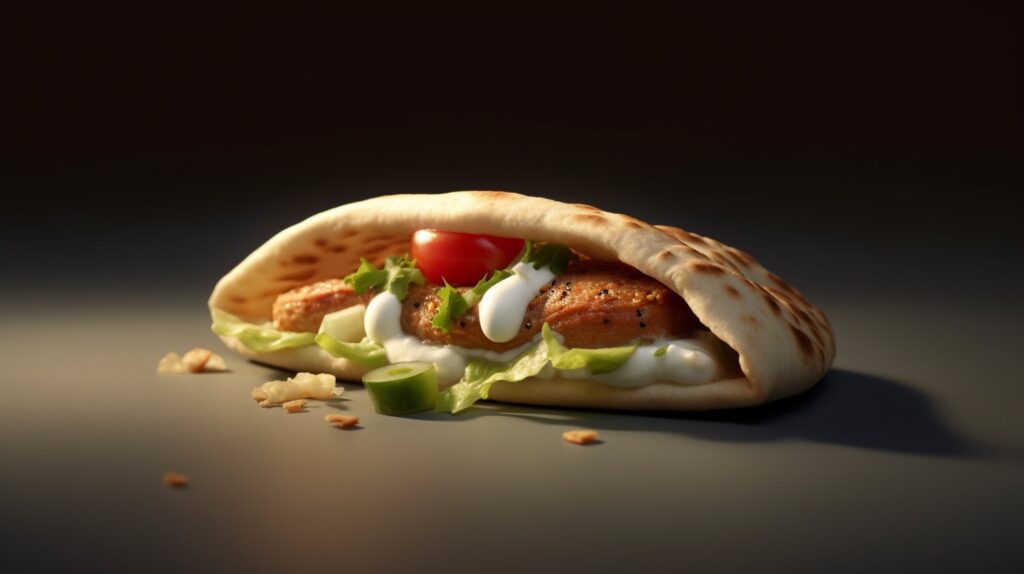Flatbreads have been a staple in many cultures for centuries, offering a simple yet delicious platform for a variety of toppings and fillings.
Among these, lavash and pita hold special places in culinary traditions from the Middle East to the Mediterranean.
Both may seem similar at first glance, but each has unique features that set it apart. This article aims to take you on a culinary journey to explore the distinctive attributes of these two flatbreads.
Main Differences
Origin and tradition form the foundation of the differences between lavash and pita. Lavash is an integral part of Armenian cuisine, known for its thin, soft texture, while pita, popular across the Middle East and the Mediterranean, is recognized by its puffiness and interior pocket.
The cooking methods also differ: lavash is traditionally baked against the walls of a clay oven, while pita is baked on the floor of the oven, leading to the puffing up that it’s famous for.

Flavor & Taste
In terms of flavor, both lavash and pita have a relatively mild, slightly nutty taste that complements a wide variety of foods.
However, the taste can slightly vary depending on the exact ingredients used and the baking method. Lavash, due to its thinness, can develop a slight smokiness if baked quickly at a high temperature.
On the other hand, pita has a more doughy, substantial taste due to its thicker texture.
Nutrition Comparison
| Lavash (per 100g) | Pita (per 100g) | |
|---|---|---|
| Calories | 275 | 275 |
| Protein | 9g | 7.5g |
| Fat | 1.2g | 1.1g |
| Carbohydrates | 56g | 55g |
| Fiber | 2g | 2.2g |
| Sodium | 439mg | 536mg |
Note: Nutritional values may vary based on exact recipe and size of the bread.
25 Facts About Differences and Similarities
Fact 1: Origin
Lavash has deep roots in Armenian cuisine, while pita is widely consumed across Middle Eastern and Mediterranean countries.
Fact 2: UNESCO Recognition
Lavash was included in UNESCO’s list of Intangible Cultural Heritage of Humanity in 2014, acknowledging its cultural significance in Armenia.
Fact 3: Thickness
Lavash is typically rolled out to be thin and flexible, while pita is thicker and puffier.

Fact 4: Shape
Lavash is often baked in large, rectangular sheets, while pita is round.
Fact 5: Cooking Method
Lavash is traditionally baked against the hot walls of a clay oven, whereas pita is placed on the floor of the oven.
Fact 6: Pockets
Pita is known for its characteristic pocket formed by steam during cooking, which can be stuffed with fillings. Lavash, being thinner, does not have this pocket.

Fact 7: Shelf Life
Lavash tends to dry out and harden faster than pita, which retains its softness longer.
Fact 8: Use in Wraps
While both can be used for wraps, the thinness of lavash makes it particularly suited to this
purpose.
Fact 9: Use as a Plate
In some cultures, large pieces of lavash are used as an edible plate for stews and other dishes.
Fact 10: Sourdough Version
There are also sourdough versions of both lavash and pita for those who prefer a tangier flavor.
Fact 11: Crackers
Both lavash and pita can be made into crunchy crackers by baking at a low temperature until crisp.
Fact 12: Versatility
Both breads can be used in a variety of dishes, from sandwiches and wraps to pizza bases and scooping up dips.
Fact 13: Texture
While both breads are soft when fresh, lavash becomes cracker-like when stale, whereas pita remains chewy.
Fact 14: Accompaniments
Both breads are often served with dips like hummus or tzatziki, or as part of a mezze platter.
Fact 15: Preservation
In traditional Armenian households, lavash is often stored in stacks and rehydrated before eating, while pita is typically consumed fresh.
Fact 16: Ingredients
At their simplest, both lavash and pita require only flour, water, and salt, though some recipes may add yeast, sugar, or other ingredients.
Fact 17: Leavening
While both breads can be made unleavened, most pita recipes include yeast to help the bread puff up and form its characteristic pocket.
Fact 18: Size
Pita bread is usually smaller and more portable, while lavash is typically larger.
Fact 19: Use in Salads
Stale pieces of lavash are used in traditional Armenian salads like fattoush, while pita is used in the similarly named Lebanese salad, fattoush.
Fact 20: Religious Significance
In Armenian tradition, lavash is used during the Eucharist in the Armenian Apostolic Church, while in Jewish culture, pita is used for the Sabbath meal.
Fact 21: Commercial Availability
While both breads are available commercially, pita is more globally recognized and available in most supermarkets.
Fact 22: Grilling
Lavash can also be grilled over an open flame for a smoky flavor, while pita is typically oven-baked.
Fact 23: Stuffed Pita
Pita bread is commonly used to make stuffed sandwiches like falafel or gyro.
Fact 24: Traditional Making
Making lavash is a communal activity in Armenia, with several women working together to roll out and bake the bread.
Fact 25: Adaptations
Both breads have been adapted in different cuisines. For instance, the Indian ‘naan’ is similar to pita, and ‘tortilla’ in Mexican cuisine has similarities with lavash.
Related Recipes
— Bazlama — Turkish Pita style Flatbread (Pan Roasted) Explore the art of making Bazlama, a Turkish pita-style flatbread, pan-roasted to perfection, adding a unique dimension to your baking skills and Turkish cuisine experience.
— Soft and thin lavash in a pan. For kebabs and shawarma — Learn how to create soft and thin lavash in a pan, the perfect accompaniment for your homemade kebabs and shawarma, with this easy-to-follow guide.
— No-Yeast Pita Bread Roasted in a Pan — Dive into this simple yet satisfying recipe for no-yeast pita bread, pan-roasted for convenience and speed, without compromising on flavor or texture.
Conclusion
Lavash and pita, despite their shared origins in the broad family of flatbreads, offer distinct tastes, textures, and culinary uses that make them unique. Whether you prefer the thin flexibility of lavash or the puffy pocket of pita, exploring these breads can open up a world of delectable possibilities. They truly embody the spirit of their respective cultures, offering a slice of history in every bite. The next time you relish these flatbreads, remember the rich cultural heritage they carry and the culinary diversity they represent.
